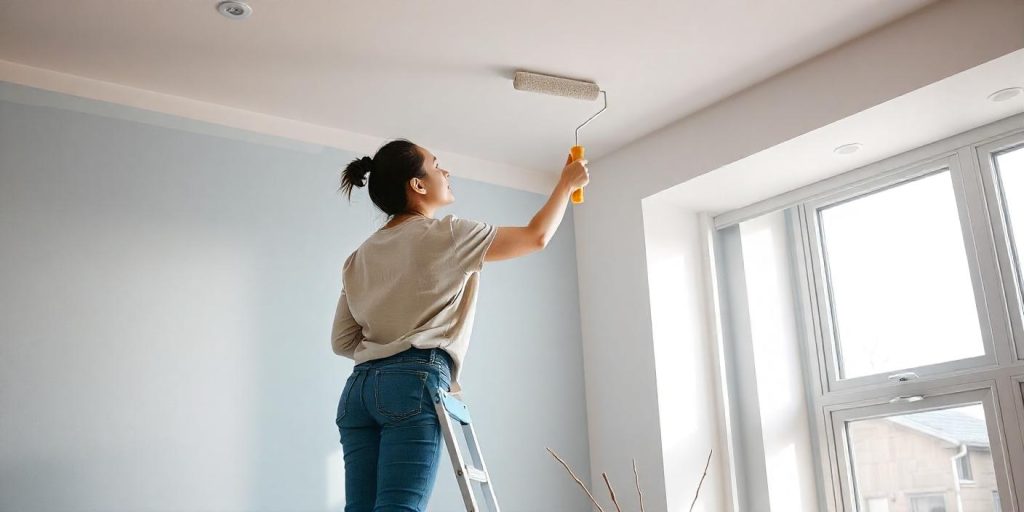Painting walls near a ceiling can be tricky, especially when you want clean, straight lines without smudging or accidentally painting the ceiling.

This guide will walk you through the tools, techniques, and tips needed to achieve a professional finish when painting near ceilings.
Contents
Why Proper Technique Matters
Clean Lines Enhance Aesthetics
- A crisp edge between the ceiling and walls creates a polished look.
- Prevents distractions from uneven or messy lines.
Avoiding Ceiling Smudges
- Proper technique reduces the risk of accidentally getting paint on the ceiling, saving you time and effort on touch-ups.
Tools and Materials Needed
Tools
- Painter’s tape
- Angled paintbrush (2-inch works best)
- Paint roller with an extension pole
- Edging tool or trim guide
- Drop cloths
Materials
- High-quality wall paint
- Ceiling paint (if touch-ups are needed)
- Primer (optional, for darker walls or color changes)
Step-by-Step Guide to Painting Walls Near a Ceiling
Step 1: Prepare the Room
- Clear the Area
- Move furniture out or to the center of the room.
- Cover floors and furniture with drop cloths.
- Clean the Walls and Ceiling
- Remove dust and cobwebs using a microfiber cloth or vacuum.
- Wash any grime with a mild soap solution.
- Inspect the Ceiling
- Repair any cracks or imperfections using spackle and sand smooth.
Step 2: Apply Painter’s Tape
- Choose High-Quality Tape
- Opt for painter’s tape designed for delicate surfaces to avoid damage to the ceiling.
- Apply Along the Ceiling Edge
- Press the tape firmly along the edge where the wall meets the ceiling.
- Ensure there are no gaps to prevent paint bleed.
- Check Alignment
- Use a level or straight edge to verify the tape’s position.
Step 3: Cut In with an Angled Brush
- Load the Brush Properly
- Dip only the tip of the angled brush into the paint.
- Wipe off excess paint on the edge of the can or tray.
- Paint Along the Edge
- Use the angled edge to create a smooth line along the tape.
- Work in small sections to maintain control.
- Feather the Edges
- Blend the paint slightly downward to make rolling easier.
Step 4: Use an Edging Tool for Precision
- Choose the Right Tool
- Edging tools or trim guides can help maintain a clean line.
- Keep the Tool Clean
- Wipe off excess paint regularly to prevent smudges.
- Guide Along the Ceiling Edge
- Hold the tool firmly against the ceiling and paint just below it.
Step 5: Roll the Rest of the Wall
- Start Below the Edges
- Begin rolling slightly below the cut-in area to avoid overlapping onto the ceiling.
- Blend with the Cut-In Paint
- Feather the rolled paint upward into the cut-in section for a seamless look.
- Use an Extension Pole
- An extension pole reduces the strain of reaching high areas.
Step 6: Remove Tape Carefully
- Let the Paint Dry Slightly
- Wait until the paint is dry to the touch but not fully cured.
- Peel at an Angle
- Pull the tape back at a 45-degree angle to avoid tearing the paint.
- Touch Up as Needed
- Use a small brush to correct any imperfections.
Tips for Painting Near Ceilings
Choose the Right Paint
- Use ceiling paint for touch-ups to match the original finish.
- Opt for a matte or satin finish for walls to reduce glare and imperfections.
Work in Natural Light
- Bright lighting helps you see edges clearly, ensuring precise lines.
Practice Steady Movements
- Slow, controlled brushstrokes produce better results than rushed painting.
Common Mistakes and How to Avoid Them
Skipping Tape
- Even if you have a steady hand, tape ensures a more professional result.
Overloading the Brush
- Too much paint can cause drips and make it harder to control the brush.
Removing Tape Too Late
- Fully cured paint can chip or peel when tape is removed.
Alternative Techniques
Freehand Painting
- Skilled painters can create straight lines without tape using only an angled brush.
Ceiling Shield Method
- Use a trim guide or plastic shield to protect the ceiling while painting.
Laser Leveling
- High-tech laser levels can guide you for a perfectly straight line.
Caring for Your Newly Painted Walls
Avoid Touching the Ceiling
- Use a gentle cleaner and a damp cloth for spot cleaning.
- Refrain from scrubbing near the ceiling line to prevent damage.
Regular Maintenance
- Dust the walls and ceiling periodically to maintain a clean appearance.
Conclusion
Painting walls near a ceiling may seem challenging, but with the right tools, preparation, and techniques, you can achieve clean, professional-looking results. By following this guide, you’ll not only save time and effort but also elevate the overall aesthetic of your room.
Whether you’re tackling a small room or a large space, mastering these skills will ensure your painting project is a success.
